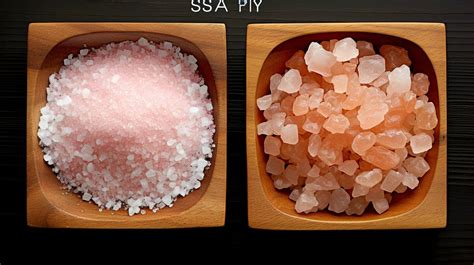Introduction
Salt, an indispensable part of our diet, comes in various forms, with rock salt and sea salt being two commonly used types. While both provide essential electrolytes, they possess distinct characteristics that influence their culinary and health applications. This comprehensive guide delves into the differences between rock salt and sea salt, empowering you to make informed choices that align with your health goals.

Rock Salt: A Geological Treasure
Rock salt, known as halite, is a mineral composed primarily of sodium chloride (NaCl). Mined from underground deposits formed millions of years ago, it undergoes a purification process to remove impurities, resulting in a pure and coarse salt.
Composition and Mineral Content
Rock salt contains primarily sodium and chloride ions, with trace amounts of other minerals, including calcium, magnesium, and potassium. However, the mineral content can vary depending on the geological location of its origin.
Taste Profile and Culinary Uses
Rock salt is characterized by its large, coarse crystals that provide a salty and bold flavor. It is commonly used in cooking as a seasoning agent, often as a finishing salt to enhance the flavors of meat, vegetables, and other dishes.
Sea Salt: Harvested from the Marine Depths
Sea salt, as its name suggests, is derived from the evaporation of seawater. The process involves flooding shallow coastal basins with seawater and allowing the sun and wind to evaporate the water, leaving behind the salt crystals.
Composition and Mineral Content
Sea salt contains a wider range of minerals than rock salt, including sodium, chloride, magnesium, calcium, potassium, and trace amounts of other elements. The composition can vary based on the location, temperature, and evaporation rate.
Taste Profile and Culinary Uses
Sea salt exhibits a finer texture and smaller crystals than rock salt. Its flavor profile is generally milder and more delicate, with a slightly briny undertone. It is often preferred in gourmet cooking and as a finishing salt for dishes that require a more subtle salty taste.
Comparison Table: Rock Salt vs. Sea Salt
| Feature | Rock Salt | Sea Salt |
|---|---|---|
| Origin | Mined from underground | Evaporated from seawater |
| Composition | Primarily sodium chloride (NaCl) | Sodium chloride (NaCl) with trace minerals |
| Texture | Large, coarse crystals | Fine, smaller crystals |
| Flavor | Bold and salty | Milder and briny |
| Culinary Uses | Seasoning, finishing salt | Gourmet cooking, finishing salt |
Health Considerations
Both rock salt and sea salt contribute to the body’s electrolyte balance, essential for hydration and nerve function. However, their mineral content differences may offer certain health implications.
Sodium Content
Rock salt typically contains a higher sodium content than sea salt, with the exact amount varying depending on the source. While sodium is necessary for proper body function, excessive consumption can contribute to high blood pressure and other health issues.
Mineral Content
Sea salt, with its higher mineral content, provides additional trace elements that may have health benefits. For instance, magnesium has been associated with improved sleep, while potassium supports heart and blood vessel health.
Which Salt to Choose?
The choice between rock salt and sea salt ultimately depends on your personal preferences, culinary needs, and health considerations.
Choose Rock Salt for:
- Bold flavor and seasoning purposes
- Budget-friendly option
- Conservative sodium intake
Choose Sea Salt for:
- Subtle and briny flavor
- Gourmet cooking and finishing salt
- Additional trace minerals
Innovative Applications: Beyond Seasoning
The culinary and health benefits of rock salt and sea salt extend beyond their use as seasoning agents.
- Rock Salt Lamps: Large blocks of rock salt, when heated, emit negative ions that may have air-purifying and mood-boosting effects.
- Sea Salt Soaks: Dissolving sea salt in warm water creates a relaxing and detoxifying foot soak that can promote better sleep and reduce muscle soreness.
- Salt Therapy (Halotherapy): Inhaling salt-infused air in specialized salt chambers or caves has been shown to improve respiratory conditions, reduce stress, and enhance overall well-being.
Conclusion
Rock salt and sea salt, though fundamentally different in origin and composition, offer unique culinary and health attributes. Understanding their differences allows you to make informed choices that align with your taste preferences and health goals. Whether you seek the bold flavor of rock salt or the subtle brine of sea salt, incorporating these natural treasures into your diet can enhance your cooking and well-being.
